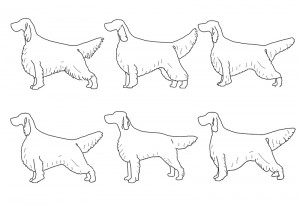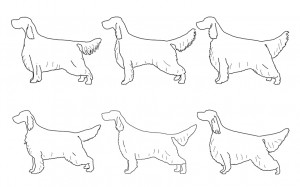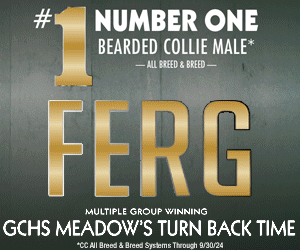Breed Priorities – The English Setter
Click here to read the complete article
By Nikki Riggsbee
The English Setter was one of nine Sporting breeds first recognized when AKC was formed in 1878, and an English Setter was the first registered with registration number 1. They were used for hunting before there were reliable firearms. And when guns started to be used, they modified their style a bit and kept on working.
We invited English Setter breeder-judges and breed mentors to participate in a survey to identify their breed’s priorities based on their standard. We found more judges than we expected – nineteen. Sixteen responded, including three that declined. Eight surveys were returned by this group.
Twenty-four breed mentors were also contacted, and eighteen agreed to participate. Fifteen surveys were received from the mentors, for a total of 23 from both groups. One survey was not completely in entirety, but we counted what was there.
Those experts who responded averaged more than 42 years in the breed. Those who were approved to judge have done so for over 20 years on average. Most of the judges have judged their national, and all have judged other English Setter specialties.
English Setter Virtues
The survey included a list of virtues taken from the English Setter standard for the experts to prioritize. The list of characteristics is below in sequence by the average of the ranks, with 1 being the most important.
1. Gaiting with long reach, strong drive…firm topline
2. Gentle, affectionate, friendly
3. Shoulder blade well laid back
4. Topline level or sloping slightly
5. Upper arm equal in length and forming nearly a right angle with the shoulder blade
6. Head long and lean with a well-defined stop
7. Wide, muscular thighs, well-developed lower thighs
8. Stifle well bent and strong
9. Muzzle long and square viewed from side
10. Neck long, graceful, muscular, lean, arched
11. Tail continuation of topline, carried straight and level with back
12. Brisket deep enough to reach elbow
13. Eyes dark brown, nearly round, fairly large
14. Males decidedly masculine…Females decidedly feminine
15. Dogs about 25”; bitches about 24”
16. Flat-coated with feathering of good length
The biggest majorities, more than three-quarters, agreed on first place “Gaiting with long reach, strong drive…firm topline” and last place “Flat-coated with feathering of good length.” Almost all who felt strongly about movement placed it first or second.
Fifteen of the group felt similarly about “Males decidedly masculine…Females decidedly feminine” (14th) and “Dogs about 25”; bitches about 24”” (15th). Almost a third thought “Size” was somewhat more important, but not enough to change its place in the list.
Almost sixty percent concurred on several virtues: “Gentle, affectionate, friendly” (2nd), “Shoulder blade well laid back” (3rd), “Upper arm equal in length and forming nearly a right angle with shoulder blade” (5th), “Stifle well bent and strong” (8th), and “Eyes dark brown, nearly round, fairly large” (13th). “Shoulder layback” (3rd) was placed in the second quartile on seven surveys, or it would have ranked higher. “Stifle angulation” (8th) had a similar number rank it above average in importance, or it would have ranked lower.
The smallest majorities agreed on two virtues: “Neck long, graceful, muscular, lean, arched” (10th) and “Brisket deep enough to reach elbow” (12th). “Brisket deep” (12th) had a majority place it about midpoint, but a third of the experts had it much lower, which landed it on a lower rank.
Eleven experts had “Topline level or sloping slightly” (4th) in the top quartile, but a third had it distinctly below average in importance. Half also agreed on “Wide, muscular thighs, well developed lower thighs” (7th).
“Head long and lean with well-defined stop” (6th) was considered very important by forty percent, but almost as many had it distinctly below midpoint. “Muzzle long and square viewed from side” (9th), another head component, had a similar split opinion. At the other end of the dog, “Tail continuation of topline, carried straight and level with back” (11th) was less important for forty percent, but above midpoint for almost as many. Some mentioned that a tail carried too high was a current problem.
“Gait” (1st) averaged almost two points ahead of second place, confirming its top importance. “Mascu-line/feminine” (14th) was almost two points behind “Eyes dark brown” (13th), emphasizing the lesser importance of the last three virtues in the list.
“Gentle, affectionate, friendly” (2nd) and “Shoulder laid back” (3rd) were less than a tenth of a point apart, so additional input could change their relative rank. The same applied to “Topline level/sloping” (4th) and “Front right angle” (5th). “Stifle well bent, strong” (8th) and “Muzzle long/square” (9th) were similarly close.
English Setter Faults
The experts also ranked a list of faults from most serious to least serious. The faults were taken either directly from the standard or derived from it. Below is the list in sequence by the average placement, with 1 being the most serious.
1. Shyness, fear, or viciousness
2. Lacking effortless graceful movement, while efficiently covering ground
3. Topline with sway or drop from withers to tail
4. Hock joints tending to turn in or out when standing or gaiting
5. Elbows tending to turn in or out when standing or gaiting
6. Forechest not well-developed
7. Upper arm not forming nearly right angle with shoulder blade
8. Tail not carried straight and level with the back
9. Coarseness
10. Eyes deepset or protruding or haw exposed
11. Neck not long
12. Over-refinement
13. Muscles flabby, not hard
14. Heavy patches of color on body
15. Curl or wooliness in coat
16. Coat so excessive as to hide lines, movement, or to affect function
The biggest majority of all – nineteen – agreed that “Shyness, fear, or viciousness” (1st) was the most serious fault; seventeen placed it first. With the lowest average rank was “Coat so excessive as to hide lines, movement, or to affect function” (16th), with eighteen experts having it at or near the bottom.
Over seventy-five percent concurred on the relative problem of these faults: “Topline with sway or drop from withers to tail” (3rd), “Neck not long” (11th), “Heavy patches of color on body” (14th), and “Curl or wooliness in coat” (15th). No split decisions on the bigger majorities.
Sixteen experts ranked “Lacking effortless, graceful movement … while covering ground efficiently” (2nd) in the top quartile, supporting “Gait” as the top virtue. Fifteen surveys agreed on “Hock joints tending to turn in or out when standing or gaiting” (4th) and “Elbows tending to turn in or out when standing or gaiting” (5th), grouping other movement faults highly, near second place “Lacking effortless movement.”
“Forechest not well-developed” (6th) had an odd distribution. It had a small majority place it fairly highly. But an equal number, overlapping with the first group, had all the ranks within the second quartile.
Half the group similarly valued “Upper arm not forming nearly right angle with shoulder blade” (7th), “Eyes deepset or protruding or haw exposed” (10th), and “Muscles flabby, not hard” (13th). Another nine experts placed “Front not right angle” as more important which raised its seriousness. Six others had “Flabby” as a more serious problem, but it didn’t affect its position in the list.
“Tail not carried straight and level with the back” (8th) was a lesser problem for ten, but eight thought it much more of a problem. “Coarseness” had a similar distribution of opinions, with the rest putting it all over.
Less than a tenth of a point separated the average ranks for “Hock joints tending to turn in or out” (4th) and “Elbows tending to turn in or out” (5th), so that more surveys could change their relative positions. “Forechest not well-developed” (6th) and “Upper arm not forming nearly right angle with shoulder blade” (7th) were similarly close. Even closer were “Tail not carried straight and level with the back” (8th) with “Coarseness” (9th) and also “Eye faults” (10th) with “Neck not long” (11th).
Two points separated the average ranks of “Front not right angle” (7th) and “Tail faults” (8th), confirming the greater seriousness of the first seven faults.
 Eleven faults had agreement on how big a problem they were, just as there were majorities agreeing on the value on eleven virtues. The experts definitely put movement, temperament, topline, and front assemblies as important. Coat, color, and size were of lesser importance.
Eleven faults had agreement on how big a problem they were, just as there were majorities agreeing on the value on eleven virtues. The experts definitely put movement, temperament, topline, and front assemblies as important. Coat, color, and size were of lesser importance.
Outlines
The group evaluated two sets of English Setter outlines, six dogs and six bitches, and placed them as they would a dog show class, first through fourth, and then selected Best of Breed. The outlines were drawn from photos of real dogs; none is perfect. And with coat on the dogs, the experts could change their opinions if they got their hands on the dogs.
The English Setter dog with the best average placement was dog “B.” Those who placed him first commented “balance overall, nice topline, could use a more squared off lip and more decent neck,” “nice substance, clean lines,” “best outline and balance,” “lovely withers and good angles both ends, enough loin to open up side gait,” “not exaggerated,” “good head planes, short back, well let down hock, good shoulder layback, smooth neck into shoulders, forelegs under withers,” and “moderate, correct body length, good head.”
Next best average placement among the males was dog “D.” The experts who liked him said “good return of upper arm,” “well balanced,” “good outline, elegant,” “clean lines, masculine breed type, nice length of head with stop, low earset, pendant lip, elegant arched neck smoothly into solid topline, correct tailset,” and “good angles front and rear.”
 The English Setter bitch with the best average placement was bitch “X.” Those who selected her wrote “level topline, tail straight and level, balanced,” “more elegant, better apparent angles,” “moderate,” “good substance, typey head, moderate coat is a plus,” and “most balanced overall, feminine.”
The English Setter bitch with the best average placement was bitch “X.” Those who selected her wrote “level topline, tail straight and level, balanced,” “more elegant, better apparent angles,” “moderate,” “good substance, typey head, moderate coat is a plus,” and “most balanced overall, feminine.”
Next best average placement among the bitches was English Setter “W.” Notes on her included “balanced, better than the rest,” “silhouette is picture of English, moderate, balanced, feminine,” “nice head, topline, angles, short hocks,” “best overall balance,” “best outline, could be ‘doggie,’” and “not exaggerated, nice neck to shoulder.”
Best of Breed is dog “B,” with the most in all areas: the best average placement score of all, eleven first placements, and six BOB awards. Dog “A” got the next most BOB placements with three; his average placement put him fourth, but apparently those who liked him really liked him. No other outline was placed BOB more than twice.
Every outline was placed first by at least one expert, and every outline was out of the ribbons on at least one survey. Dogs “E” and “F” were unplaced most often among the dogs. Bitches “U” and “Z” were unplaced most often among the bitches, even though “Z” had the third best average placement.
Essential Characteristics
The experts listed four to six characteristics that a good English Setter must have. Balance was named by almost all, followed very closely by movement (effortless reach and drive). Chiseled head was next most often noted, as was expression as a separate feature. Also included were topline level or with a slight slope, gentle, friendly temperament, and correct angulation.
Movement
The survey asked what movement component they felt was most important and which movement fault was most serious.
Most important in movement was effortless reach and drive. Faulty was lack of coordination and lacking reach and drive.
Comments
The English Setter experts shared these additional comments for students of their breed.
• English Setters should be gentlemen (and ladies) with soft expressions and elegant movement.
• The English is the moderate Setter.
• Color should not make or break a dog; structure is much more important.
• The mental picture should not be a generic Setter nor should it resemble the Irish or Gordon.
• Overall balance with breed type and good temperament are most important, along with good reach and drive, a strong back, and typey head.
• This is ultimately a bird dog and should be constructed as such.
• Place high value on traits that affect movement, structure, and performance as a pointing hunter.
• Never get caught up with coat color or coat length.
• Tail should be carried level with the back (not many do any more).
• Elegance, substance, balance, no extremes.
• Must be English type, not Irish or Gordon.
• Current problems: over-angulated rears, high tail carriage, excessive coat, and more Irish type than English.
• Soft expression is a must.
• A good topline is essential for the “running gear” to work.
• Reward good fronts and good movement.
• On well-coated dogs, be sure to feel the actual body under the coat.
• Look at both sides of the dog, as the color may not be the same on both sides.
• Both dogs and bitches should have a deep muzzle, good rib spring, and good bone.
Many thanks to the English Setter judges and mentors for participating in this project.
Short URL: https://caninechronicle.com/?p=102137
Comments are closed











